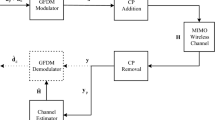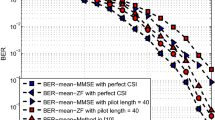Abstract
Due to hardware mismatch, the channel reciprocity of time-division duplex massive multiple-input multiple-output system is impaired. Under this condition, there exist several different approaches for base station (BS) to obtain downlink (DL) channel information based on the minimum mean-square-error (MMSE) estimation method. In this paper, we show that with the hardware mismatch parameters BS can obtain the same DL channel information via these different approaches. As the obtained DL channel information is usually imperfect, we propose a precoding technique based on the criterion that minimizes the mean-square-error (MSE) of signal detection at the user terminals (UTs). The proposed precoding is robust to the channel estimation error and significantly improves the system performance compared to the conventional regularized zero-forcing precoding. Furthermore, we derive an asymptotic approximation of the ergodic sum rate for the proposed precoding using the large dimensional random matrix theory, which is tight as the number of antennas both at the BS and UT approach infinity with a fixed non-zero and finite ratio. This approximation can provide a reliable sum rate prediction at a much lower computation cost than Monte Carlo simulations. Simulation results show that the approximation is accurate even for a realistic system dimension.
Similar content being viewed by others
References
Marzetta T L. Noncooperative cellular wireless with unlimited numbers of base station antennas. IEEE Trans Wirel Commun, 2010, 9: 3590–3600
Rusek F, Persson D, Lau B K, et al. Scaling up MIMO: opportunities and challenges with very large arrays. IEEE Signal Process Mag, 2013, 30: 40–60
Larsson E G, Edfors O, Tufvesson F, et al. Massive MIMO for next generation wireless systems. IEEE Commun Mag, 2014, 2: 186–195
Gao X, Edfors O, Fredrik R, et al. Linear pre-coding performance in measured very-large MIMO channels. In: Proceedings of IEEE Vehicular Technology Conference (VTC Fall), San Francisco, 2011. 1–5
Marzetta T L. How much training is required for multiuser MIMO. In: Proceedings of the 40th Asilomar Conference on Signals, Systems and Computers, Pacific Grove, 2006. 359–363
Wang D M, Zhang Y, Wei H, et al. An overview of transmission theory and techniques of large-scale antenna systems for 5G wireless communications. Sci China Inf Sci, 2016, 59: 081301
Schenk T. RF Imperfections in High-rate Wireless Systems: Impact and Digital Compensation. Berlin: Springer, 2008
Zhang W C, Ren H, Pan C H, et al. Large-scale antenna systems with UL/DL hardware mismatch: achievable rates analysis and calibration. IEEE Trans Commun, 2015, 63: 1216–1229
Björnson E, Hoydis J, Kountouris M, et al. Massive MIMO systems with non-ideal hardware: energy efficiency, estimation, and capacity limits. IEEE Trans Inform Theory, 2014, 60: 7112–7139
Bourdoux A. Non-reciprocal transceivers in OFDM/SDMA systems: impact and mitigation. In: Proceedings of Radio and Wireless Conference, Boston, 2003. 183–186
Guillaud M, Slock D T M, Knopp R. A practical method for wireless channel reciprocity exploitation through relative calibration. In: Proceedings of the 8th International Symposium on Signal Processing and Its Applications, Sydney, 2005. 403–406
Shi J, Luo Q L, You L M. An efficient method for enhancing TDD over the air reciprocity calibration. In: Proceedings of IEEE Wireless Communications and Networking Conference, Cancun, 2011. 339–344
Han S Q, Yang C Y, Wang G, et al. Coordinated multipoint transmission strategies for TDD systems with non-ideal channel reciprocity. IEEE Trans Commun, 2012, 10: 4256–4270
Guillaud M, Kaltenberger F. Towards practical channel reciprocity exploitation: relative calibration in the presence of frequency offset. In: Proceedings of IEEE Wireless Communications and Networking Conference, Shanghai, 2013. 2525–2530
Rogalin R, Bursalioglu O Y, Papadopoulos H, et al. Scalable synchronization and reciprocity calibration for distributed multiuser MIMO. IEEE Trans Wirel Commun, 2014, 4: 1815–1831
Su L Y, Yang C Y, Wang G, et al. Retrieving channel reciprocity for coordinated multi-point transmission with joint processing. IEEE Trans Commun, 2014, 5: 1541–1553
Shepard C, Yu H, Anand N, et al. Argos: practical many-antenna base stations. In: Proceedings of the 18th Annual International Conference on Mobile Computing and Networking, Istanburl, 2012. 53–64
Kaltenberger F. Relative channel reciprocity calibration in MIMO/TDD systems. In: Proceedings of IEEE Future Network and Mobile Summit, Florence, 2010. 1–10
Yang H, Marzetta T. Performance of conjugate and zero-forcing beamforming in large-scale antenna systems. IEEE J Sel Area Commun, 2013, 31: 172–179
Peel C B, Hochwald B M, Swindlehurst A L. A vector-perturbation technique for near-capacity multiantenna multiuser communication-part I: channel inversion and regularization. IEEE Trans Commun, 2005, 53: 195–202
Joham M, Utschich W, Nossek J A. Linear transmit processing in MIMO communications systems. IEEE Trans Signal Process, 2005, 53: 2700–2712
Costa M H M. Writting on dirty paper. IEEE Trans Inform Theory, 1983, 29: 439–441
Hochwald B M, Peel C B, Swindlehurst A L. Vector-perturbation technique for near-capacity multiantenna multiuser communication-part II: perturbation. IEEE Trans Commun, 2005, 53: 537–544
Björnson E, Larsson E G, Marzetta T L. Massive MIMO: ten myths and one critical question. IEEE Commun Mag, 2016, 54: 114–123
Wei H, Wang D M, Wang J Z, et al. Impact of RF mismatches on the performance of massive MIMO systems with ZF precoding. Sci China Inf Sci, 2016, 59: 022302
Meng X, Jiang B, Gao X Q. Efficient co-channel interference suppression in MIMO-OFDM systems. Sci China Inf Sci, 2015, 58: 022301
Kay S M. Fundamentals of Statistical Signal Processing: Estimation Theory. Englewood Cliffs: Prentice Hall, 1993
You L, Gao X Q, Xia X-G, et al. Pilot reuse for massive MIMO transmission over spatially correlated rayleigh fading channels. IEEE Trans Wireless Commun, 2015, 14: 3352–3366
Kermoal J P, Schumacher L, Pedersen I K, et al. A stochastic MIMO radio channel model with experimental validation. IEEE Trans Commun, 2002, 20: 1211–1226
Sayeed A M. Deconstructing multiantenna fading channels. IEEE Trans Signal Process, 2002, 50: 2563–2579
Weichselberger W, Herdin M, ¨Ozcelik H, et al. A stochastic MIMO channel model with joint correlation of both link ends. IEEE Trans Wirel Commun, 2006, 5: 90–100
Wagner S, Couillet R, Debbah M, et al. Large system analysis of linear precoding in correlated MISO broadcast channels under limited feedback. IEEE Trans Inform Theory, 2012, 58: 4509–4537
Hoydis J, Brink S T, Debbah M. Massive MIMO in the UL/DL of celluar networks: how many antennas do we need? IEEE J Sel Areas Commun, 2013, 31: 160–171
Couillet R, Debbah M. Random Matrix Methods for Wireless Communications. Cambridge: Cambridge University Press, 2011
Silverstein J W, Bai Z D. On the empirical distribution of eigenvalues of a class of large dimensional random matrices. J Multivar Anal, 1995, 54: 175–192
Jacks W C, Cox D C. Microwave Mobile Communications. New York: Wiley, 1994
Acknowledgements
This work was supported by National Natural Science Foundation of China (Grant Nos. 61320106003, 61471113, 61521061, 61631018), National High Technology Research and Development Program of China (863) (Grant Nos. 2015AA01A701, 2014AA01A704), National Science and Technology Major Project of China (Grant No. 2014ZX03003006-003), and Huawei Cooperation Project.
Author information
Authors and Affiliations
Corresponding author
Rights and permissions
About this article
Cite this article
Chen, Y., Gao, X., Xia, XG. et al. Robust MMSE precoding for massive MIMO transmission with hardware mismatch. Sci. China Inf. Sci. 61, 042303 (2018). https://doi.org/10.1007/s11432-016-9126-1
Received:
Revised:
Accepted:
Published:
DOI: https://doi.org/10.1007/s11432-016-9126-1




